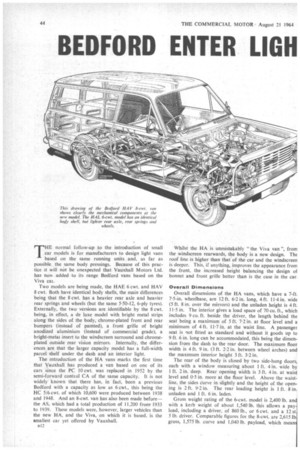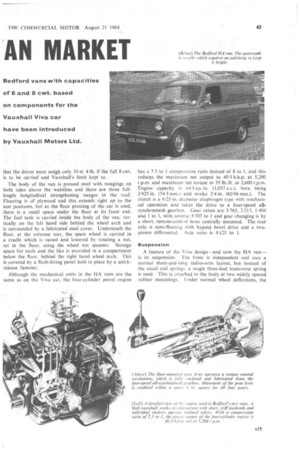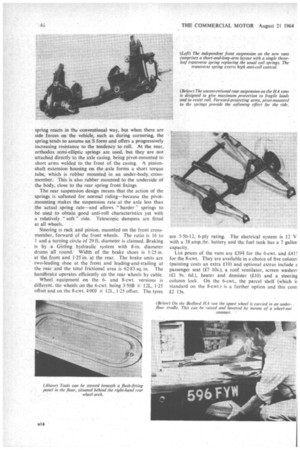BEDFORD ENTER LIGH AN MARKET
Page 48

Page 49

Page 50

If you've noticed an error in this article please click here to report it so we can fix it.
THE normal follow-up to the introduction of small car models is for manufacturers to design light vans based on the same running units and, as far as possible the same body pressings. Because of this practice it will not be unexpected that Vauxhall Motors Ltd. has now added to its range Bedford vans based on the Viva car.
Two models are being made, the HAE 6 cwt. and HAV 8 cwt. Both have identical body shells, the main differences being that the 8 cwt. has a heavier rear axle and heavier rear springs and wheels (but the same 5-50-12, 6-ply tyres). Externally, the two versions are identifiable by the 8 cwt. being, in effect, a de luxe model with bright metal strips along the sides of the body, chrome-plated front and rear bumpers (instead of painted), a front grille of bright anodized aluminium (instead of commercial grade), a bright-metal insert to the windscreen surround and chromeplated outside rear vision mirrors. Internally, the differences are that the larger capacity model has a full-width parcel shelf under the dash and an interior light.
The introduction of the HA vans marks the first time that Yauxhall has produced a van based on one of its cars since the PC 10 cwt. was replaced in 1952 by the semi-forward control CA of the same capacity. It is not widely known that there has, in fact, been a previous Bedford with a capacity as low as 6 cwt., this being the HC 5/6 cwt. of which 10,600 were produced between 1938 and 1948. And an 8-cwt. van has also been made before— the AS, which had a total production of 11,200 from 1933 to 1939. These models were, however, larger vehicles than the new HA, and the Viva, on which it is based, is the smallest car yet offered by Vauxhall. Whilst the HA is unmistakably " the Viva van ", from the windscreen rearwards, the body is a new design. The roof line is higher than that of the car and the windscreen is deeper. This, if anything, improves the appearance frorr the front, the increased height balancing the design of bonnet and front grille better than is the case in the car.
Overall Dimensions
Overall dimensions of the HA vans, which have a 7-ft, 7-5-in, wheelbase, are 12 ft. 6.2 in. long, 4 ft. 11.4 in. wide (5 ft. 8 in. over the mirrors) and the unladen height is 4 ft. 11.5 in. The interior gives a load space of 70 cu. ft., which includes 9 Cu. ft. beside the driver, the length behind the seat being a maximum of 5 ft. 7-2 in. at floor level and a minimum of 4 ft. 11.7 in. at the waist line. A passenget seat is not fitted as standard and without it goods up to 9 ft. 6 in. long can be accommodated, this being the dimension from the dash to the rear door. The maximum floor width is 4 ft. 9 in. (3 ft. 2.2 in. between wheel arches) and the maximum interior height 3 ft. 3-2 in.
The rear of the body is closed by two side-hung doors, each with a window measuring about 1 ft. 4 in. wide by 1 ft. 2 in. deep. Rear opening width is 3 ft. 4 in. at waist level and 0.5 in. more at the floor level. Above the waistline, the sides curve in slightly and the height of the opening is 2 ft. 9.2 in. The rear loading height is I ft. 8 in. unladen and 1 ft. 6 in. laden.
Gross weight rating of the 6-cwt. model is 2,400 lb. an with a kerb weight of about 1,540 lb. this allows a pay load, including a driver, of 860 lb., or 6 cwt. and a 12 St Sib. driver. Comparable figures for the 8-cwt. are 2,615 lb gross, 1,575 lb. curve and 1,040 lb. payload, which mean that the driver must weigh only 10 St. 4 lb. if the full 8 cwt. is to be carried and Vauxhall's limit kept to.
The body of the van is pressed steel with swagings on both sides above the waistline and there are three fulllength ,longitudinal strengthening swages in the roof. Flooring is of plywood and this extends right up.to the seat positions, but as the floor pressing of the car is used, there is a small space underthe floor at its front end. The fuel tank is carried inside the body of the van, vertically on the left hand "side behind the wheel arch and is surrounded by a fabricated steel cover. Underneath the floor, at the extreme rear, the spare wheel is carried in a cradle which is raised and lowered by rotating a nut, set in the floor, using the 'wheel nut spanner. Storage space for tools and the like is provided in a compartment below the floor, behind the right hand wheel arch. This is covered by a flush-fitting panel held in place by a quickrelease fastener.
Although the mechanical units in the HA vans are the same as on the Viva car, the four-cylinder petrol engine
has a 7.3 to 1 compression ratio instead of 8 to 1, and this reducps the maximum net output to 40-3 b.h.p. at 5,200 r.p.m. and maximum net torque to 55 lb./ft. at 2,600 r.p.m. Engine capacity is (A-5 cu. in. (1,057 c.c.), bore being 2.925 in. (74.3 mm.) and stroke 2.4 in. (60.96 mm.). The clutch is a 6.25-in.-diameter diaphragm type with mechanical operation and takes the drive to a four-speed allsynchromesh gearbox. Gear ratios are 3.765, 2.213, 1.404 and Ito 1, with reverse 3-707 to I and gear changing is by a short, remote-control lever centrally mounted. The rear axle is semi-floating with hypoid bevel drive and a twopinion differential. Axle ratio is 4-125 to I.
Suspension
A feature of the Viva design—and now the HA van— is its suspension. The front is independent and uses a normal short-and-long radius-arm layout, but instead of the usual coil springs, a single three-leaf transverse spring is used. This is attached to the body at two widely spaced rubber mountings. Under normal wheel deflections, the spring reacts in the conventional way, but when there are side forces on the vehicle, such as during cornering, the spring tends to assume an S form and offers a progressively increasing resistance to the tendency to roll. At the rear, orthodox semi-elliptic springs are used, but they are not attached directly to the axle casing, being pivot-mounted to short arms welded to the front of the casing. A pinionshaft extension housing on the axle forms a short torque tube, which is rubber mounted in an under-body. crOssmember. This is also rubber mounted to the underside of the body, close to the rear spring front fixings.
The rear suspension design means that the action of the springs is softened for normal riding—because the pivotmounting makes the suspension rate at the axle less than the actual spring rate—and allows " harder " springs to be used to obtain good anti-roll characteristics yet with a relatively "soft" ride. Telescopic dampers are fitted at all wheels.
Steering is rack and pinion, mounted on the front crossmember, forward of the front wheels. The ratio is 16 to I and a turning circle of 29 ft. diameter is claimed. Braking is by a Girling hydraulic system with 8-in, diameter drums all round. Width of the brake shoes is 1.25 in. at the front and 1.25 in. at the rear. The brake units are two-leading shoe at the front and leading-and-trailing at the rear and the total frictional area is 62.83 sq. in. The handbrake operates efficiently on the rear wheels by cable.
Wheel equipment on the 6and 8-cwt. versions is different, the wheels on the 6-cwt. being 3.50B X 12L, 1-25 offset and on the 8-cwt. 4.00J X I2L, 1-25 offset. The tyres are 5-50-12, 6-ply rating. The electrical system is 12 V with a 38 amp./hr. battery and the fuel tank has a 7 galkx capacity.
List prices of the vans are 094 for the 6-cwt. and £4l. for the 8-cwt. They are available in a choice of five colour: (painting costs an extra £10) and optional extras include a passenger seat (£7 10s.), a roof ventilator, screen washer: (£1 9s. 6d.), heater and demister (£10) and a. steering column lock. On the 6-cwt., the parcel shelf (which standard on the 8-cwt.) is a further option and this cost: £2 13s.






















































































































